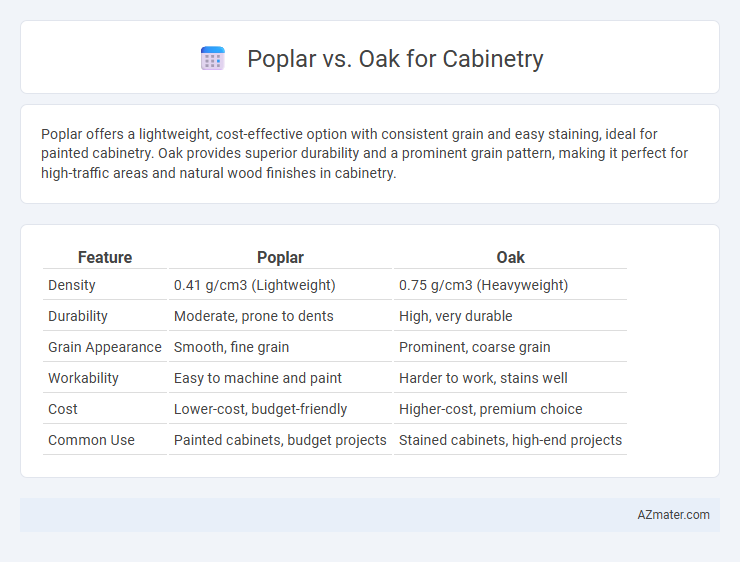Poplar offers a lightweight, cost-effective option with consistent grain and easy staining, ideal for painted cabinetry. Oak provides superior durability and a prominent grain pattern, making it perfect for high-traffic areas and natural wood finishes in cabinetry.
Table of Comparison
| Feature | Poplar | Oak |
|---|---|---|
| Density | 0.41 g/cm3 (Lightweight) | 0.75 g/cm3 (Heavyweight) |
| Durability | Moderate, prone to dents | High, very durable |
| Grain Appearance | Smooth, fine grain | Prominent, coarse grain |
| Workability | Easy to machine and paint | Harder to work, stains well |
| Cost | Lower-cost, budget-friendly | Higher-cost, premium choice |
| Common Use | Painted cabinets, budget projects | Stained cabinets, high-end projects |
Introduction to Poplar and Oak in Cabinetry
Poplar and oak are popular hardwood choices for cabinetry, each offering distinct characteristics in durability and appearance. Poplar is a softer wood with a smooth grain and light color, making it ideal for painted cabinets and intricate designs. Oak, known for its strength and prominent grain patterns, provides a more traditional, rustic look and excels in stain application for rich finishes.
Poplar vs Oak: Wood Characteristics
Poplar wood features a light color with a fine, uniform grain that is softer and easier to work with compared to oak. Oak has a distinctive coarse grain and is significantly harder and denser, providing superior durability for cabinetry. While poplar is more affordable and takes paint finishes well, oak's natural grain and strength make it ideal for stained or natural wood cabinetry.
Durability Comparison: Poplar and Oak Cabinets
Poplar cabinets offer moderate durability with a Janka hardness rating of approximately 540, making them suitable for light to medium use but prone to dents and scratches. Oak cabinets, particularly red and white oak, have a significantly higher hardness rating around 1,200 to 1,360, providing superior resistance to wear and impact, ideal for high-traffic kitchen environments. Oak's dense grain structure contributes to its long-lasting durability, maintaining structural integrity and appearance under heavy daily use better than poplar.
Grain Patterns and Aesthetic Appeal
Poplar features a straight, fine grain with subtle patterns, often showcasing a soft, light green to off-white color that accepts paint exceptionally well, making it ideal for painted cabinetry. Oak exhibits a prominent, coarse grain with distinctive rays and flecks, offering rich texture and warmth in natural finishes, preferred for traditional and rustic cabinet designs. Choosing between poplar and oak hinges on desired grain visibility and finish, where poplar suits smooth, painted aesthetics, and oak excels in showcasing natural wood character.
Finishing Options: Stain and Paint Results
Poplar offers excellent versatility for cabinetry with smooth grain patterns that absorb paint evenly, resulting in vibrant and consistent finishes ideal for painted cabinets. Oak's prominent grain texture responds well to staining, enhancing its natural character and providing rich, warm tones but may require additional preparation for a smoother paint application. Choosing between poplar and oak hinges on preferred finishing techniques: poplar excels in painted surfaces, while oak is favored for stained, natural wood looks.
Cost Differences: Poplar vs Oak for Cabinets
Poplar cabinets are generally more affordable than oak cabinets, with poplar costing approximately 20-40% less per board foot, making it a budget-friendly option for kitchen renovations. Oak, known for its durability and prominent grain, commands a higher price due to its strength and aesthetic appeal, often leading to increased overall project costs. Choosing poplar can reduce material expenses while still providing a smooth, paintable surface, whereas oak offers a natural wood grain finish that justifies its premium price for high-end cabinetry.
Workability and Installation Ease
Poplar offers superior workability for cabinetry due to its softer texture, making it easier to cut, shape, and sand compared to oak. Oak's hardness provides greater durability but can present challenges during installation, requiring more effort for cutting and fastening. The ease of installation with poplar often translates to faster project completion and fewer tool wear issues.
Maintenance and Longevity
Poplar offers low maintenance with its smooth grain and resistance to dents, making it ideal for cabinetry in high-traffic areas, but it ranks lower in durability compared to oak. Oak, renowned for its strength and hardness, requires periodic sealing or finishing to maintain its appearance and resist moisture damage, ensuring exceptional longevity in cabinetry. Choosing oak cabinetry often means investing in a material that withstands wear and tear over decades, while poplar suits budgets focused on ease of upkeep and moderate durability.
Environmental Impact and Sustainability
Poplar cabinetry offers a more sustainable option compared to oak due to its faster growth rate and ability to regenerate quickly, reducing deforestation pressures. Oak trees require longer maturation periods, making their harvesting less environmentally friendly and contributing to habitat disruption. Choosing poplar supports responsible forestry practices and lowers carbon footprint in cabinetry production.
Choosing the Right Wood for Your Cabinetry Needs
Poplar offers a smooth, affordable option with consistent grain patterns and easy paintability, making it ideal for cabinets requiring a painted finish. Oak provides exceptional durability and showcases prominent grain patterns, perfect for natural or stained cabinetry emphasizing strength and traditional aesthetics. Selecting between poplar and oak hinges on priorities such as budget, desired finish, and the cabinetry's functional demands.

Infographic: Poplar vs Oak for Cabinetry
 azmater.com
azmater.com